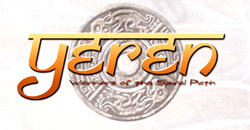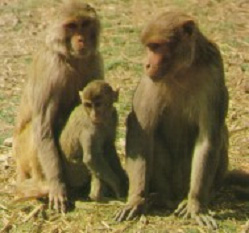
Agent Bible
Wild Animals: Primates

Agent
Bible
Wild
Animals: Primates
 |
||||||||||||||
|
Habitat: |
This monkey is small with fine fur, but lives in an amazing range of places. They prefer forested areas, obviously, coming tot eh ground only when they feel secure in order to find water, sunbathe, forage for treats in the grass and relax with each other. In much of Asia they are frequently seen in villages and towns where they can become a pest but are tolerated. many temples have a colony that live in their courtyards and are treated as part of the family. | |||||||||||||
|
Diet:
|
In the wild, the vast majority of the langurs day is spent looking for food; nuts, seeds, fruits, grasses, leaves, roots, insects are all part of the daily diet. With their move towards town and village life, this has changed and now langurs are frequently a pest of agricultural land, digging up seeds and young plants, raiding fruit trees and breaking plants. They also scavenge in tips and even venture into houses to steal food. | |||||||||||||
|
LifeStyle:
|
Troops of langurs can number upto 70 individuals and are based on a strong matriarchal system. The oldest female leads the troop; although each troop will have at least one adult male, he is usually more concerned with keeping rival males away from his harem than anything else. Females do not leave the troop of their birth but males are chased out as they reach adolescence, and frequently join all-male bands that roam around looking for troops to take over. The ousting of one male from a troop and his replacement with another can be an extremely traumatic time for the group - chases, violence and even death (the intruding males often kill infants sired by the defeated male to ensure that all new infants will bear their genes). Groups are usually sociable and much time is spent grooming and sunbathing together. | |||||||||||||
|
Special
Skills:
|
Pretty near human sight - probably a bit sharper and more used to spotting things in dense foliage. Good sense of smell - can detect ripening fruit across a forest. Sense of touch is good in hands, feet and mouth - useful for manipulation of objects. Hearing is acute, but nothing too special. Taste allows them to distinguish foods that may be toxic. | |||||||||||||
|
||||||||||||||
|
|
||||||||||||||
 |
||||||||||||||
|
Habitat: |
The grey langur is slightly more delicate and shy than its larger cousin, and tends to spend much of its time in tropical forest. It is found in temperate forest also, but does not usually enter villages or towns except at night to raid fields. | |||||||||||||
|
Diet:
|
The grey langur probably has the more natural diet - they live almost exclusively on leaves, fruit and green shoots. They do not come down to the ground as often as larger langurs, and only raid fields in times of hardship - their preferred food from fields is maize. | |||||||||||||
|
LifeStyle:
|
Socially, grey langurs are very similar to Hanuman Langurs - a troop is led by an adult female and males occasionally take over the troop from each other. They are smaller and much more shy than Hanumans langur and spend less time on the ground; when they do come down it is usually to move to another patch of trees and the troop is quiet, tense and wary. | |||||||||||||
|
Special
Skills:
|
Pretty near human sight - probably a bit sharper and more used to spotting things in dense foliage. Good sense of smell - can detect ripening fruit across a forest. Sense of touch is good in hands, feet and mouth - useful for manipulation of objects. hearing is acute, but nothing too special. taste allows them to distinguish foods that may be toxic. | |||||||||||||
|
||||||||||||||
|
|
||||||||||||||
 |
||||||||||||||
|
Habitat: |
Rhesus macaques are endlessly adaptable. Their natural habitat is uncertain as they have been found in all sorts of places from forest to snowy mountains and even thriving in towns. They tend to spend a lot of time on the ground looking for food and escape up into nearby trees when their sentry gives the alarm. Although they are found in Japan living in the mountains, they do not tend to live quite so high in Tibet and are usually not found higher than the edges of the steppe - probably largely due to the scarcity of food rather than anything else. | |||||||||||||
|
Diet:
|
The diet of rhesus macaques varies depending on seasons and locations, but is largely vegetarian. They enjoy fruits, tubers, roots, leaves, nuts, berries and are now becoming a pest as they decimate agricultural crops. In towns they may steal or beg food from humans and in many areas actually live as privileged 'guests' in temples. They, like most monkeys, have large cheek pouches that they can stuff with excess food for later caching or eating. | |||||||||||||
|
LifeStyle:
|
These monkeys tend to live as a harem tied to a male or group of males. Troops are often large - over 100 animals - and usually in a state approaching turmoil as alliances are made and broken, fights break out over food and macaques chase each other around. Males usually have only a year or two to enjoy their privileged position as they tend to get ousted by younger males or roaming bullies on a regular basis. Females stay with their birth group and form deep alliances with each other that help them to survive these hostile take-overs. | |||||||||||||
|
Special
Skills:
|
These monkeys are really the basic model of primates. They do not have particularly great senses - better than human on most counts - but their vision is good through foliage, and their sense of smell allows them to find ripe fruits. It is thought they do have colour vision. | |||||||||||||
|
||||||||||||||
|
|
||||||||||||||
 Tibetan stump-tailed macaque have long, dense, grey/brown fur, with
whiskers and a beard that are lighter than the top of the head. The infants
have black and silver fur, which changes to yellow at the age of two.
Tibetan stump-tailed macaque have long, dense, grey/brown fur, with
whiskers and a beard that are lighter than the top of the head. The infants
have black and silver fur, which changes to yellow at the age of two.
|
||||||||||||||
|
Habitat: |
For the most part, this macaque lives in the broad-leaved forests of the temperate region of Tibet, but is also found in tropical forest and even occasionally at high altitudes, where its thick coat protects it against the cold. | |||||||||||||
|
Diet:
|
These monkeys eat whatever they can find. Their normal diet would include fruit, leaves, nuts, roots and so on, but they also scavenge predators kills, eat eggs, small mammals, birds and fish if they can catch them. Living near to humans has taught them to raid farms and houses for titbits as well. | |||||||||||||
|
LifeStyle:
|
Tibetan stump-tailed macaques live in multi-male, multi-female groups. Unusually for monkeys, the males of the group are in control and form close alliances with each other. It is believed that they may occasionally even go hunting for small mammals such as fawns. The females form their own groups and follow the males. Extremely noisy fights break out on a regular basis, especially if two troops meet. These monkeys are very territorial and will even attempt to defend their patch against humans who wander past. The dominant males are reported to have a favourite infant, which they groom. Subordinate males recognise this and carry the favourite infant to the dominant males in order to appease them. Tibetan stump-tailed macaque are active during the day and spend most of their time on the ground. | |||||||||||||
|
Special
Skills:
|
Good sight and depth perception - can see well even in gloomy forests and thick undergrowth. Reasonable sense of smell although not excellent, and functional taste ability (toxic, ripe etc). Hearing is acute - can hear very well over short distances and hear higher pitched sounds than humans. Delicate touch in hands and mouth used for manipulating objects. | |||||||||||||
|
||||||||||||||
|
|
||||||||||||||
 |
||||||||||||||
|
Habitat: |
High mountain conifer and mixed forests, up to about 3,400m. May descend to lower elevations in winter. | |||||||||||||
|
Diet:
|
Young and tender fir and pine needles but also includes bamboo shoots, nuts, berries, bark, buds, fruits and leaves. | |||||||||||||
|
LifeStyle:
|
Troops of over one hundred and even up to 600 individuals have been reported. Births usually take place during the spring and summer, one or sometimes two young are born. Most activity takes place in trees but some feeding and social interaction including play takes place on the ground. It is a very alert animal. If frightened, the animals flee through the upper levels of the canopy at great speed. | |||||||||||||
|
Special
Skills:
|
Excellent colour vision at high resolution. Good sense of smell - better than human. | |||||||||||||
|
||||||||||||||